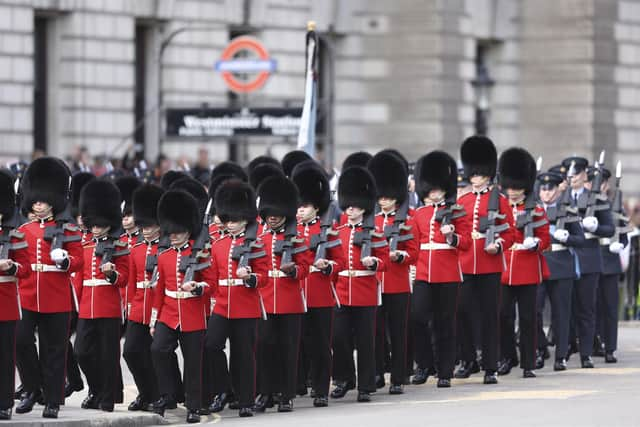Who are the King’s Guard and King’s Life Guard? Role in Queen’s funeral explained
and live on Freeview channel 276
The funeral of the Queen has started at Westminster Abbey.
However it is not the end of the ceremonial events.
Elizabeth II’s coffin will be taken by a procession to Wellington Arch before being put into a hearse to be taken to Windsor.
Advertisement
Hide AdAdvertisement
Hide AdThe Queen will be laid to rest after a committal service at King George VI Memorial Chapel in Windsor.
The King’s Guard and the King’s Life Guard will play a role in the coming ceremonial events.
Here is all you need to know:
Who are the King’s Guard?
The King’s Guard is the name given to the contingent of infantry responsible for guarding Buckingham Palace and St James’s Palace (including Clarence House) in London.
A changing of the guard took place last Monday 12 September with the newly recreated Number 12 Company Irish Guards stepping off from Wellington Barracks to take over from Number 7 Company Coldstream Guards, who became the King’s Guard immediately upon the death of Her Majesty Queen Elizabeth II.
Advertisement
Hide AdAdvertisement
Hide AdThe King’s Guard had been known as the Queen’s Guard during the reign of the previous monarch.


Who are the King’s Life Guard?
The King’s Life Guard is conducted by soldiers of the Household Cavalry Mounted Regiment at Horse Guards.
Horse Guards is named after the troops who have mounted The King’s Life Guard here since the Restoration of King Charles II in 1660.
The Household Cavalry Mounted Regiment consists of a squadron from each of the two senior Regiments of the British Army: The Life Guards wear red tunics and white plumed helmets, and The Blues and Royals wear blue tunics and red plumed helmets.
Advertisement
Hide AdAdvertisement
Hide AdWhen The King is in London, the Guard consists of one Officer, one Corporal Major (who carries the Standard), two Non-Commissioned Officers, one Trumpeter and ten Troopers. This is known as a Long Guard.
What role will they have in the Queen’s funeral?
The King’s Guard will have a role in the procession following the service at Westminster Abbey.
At 12.15pm, The King’s Life Guard will turn out on Horse Guards and give a royal salute as the coffin passes.
The troops will be involved again at 1pm as they will turn out in the forecourt of Buckingham Palace and will give a royal salute as the coffin passes Queen Victoria Memorial.
Advertisement
Hide AdAdvertisement
Hide AdWhat role will the Army have in the procession?
A two minute’s silence shortly before midday will be followed by the Reveille, the National Anthem and a Lament played by The Queen’s Piper to bring the State Funeral Service to an end.
The Bearer Party will then carry Her Majesty’s coffin through the Great West Door to the State Gun Carriage outside, following which the Coffin Procession will set off on the journey to Wellington Arch.
A Sovereign’s Standard of the Household Cavalry will follow immediately behind the coffin. His Majesty The King will lead members of the Royal Family walking, followed by mounted elements of the Household Cavalry and representatives of the Civilian Services.
On arrival at Wellington Arch, all those members of the British Army, Royal Navy, and Royal Air Force taking part in this Procession will bid farewell to Her Majesty Queen Elizabeth II as she leaves for Windsor for the last time, having been transferred to the State Hearse.
Comment Guidelines
National World encourages reader discussion on our stories. User feedback, insights and back-and-forth exchanges add a rich layer of context to reporting. Please review our Community Guidelines before commenting.